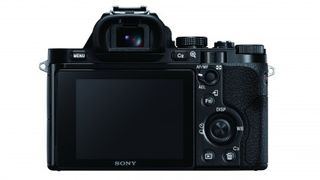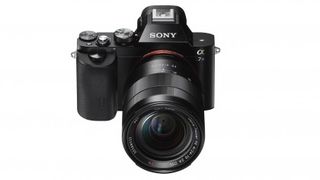Why you can trust TechRadar
Full-frame cameras have shrunk considerably over recent years with the introduction of the Canon 6D and Nikon D610, but Sony's Alpha 7-series of compact system camera (CSC) sets a new benchmark for size.
Apart from a slightly more bulbous grip, the A7S (and A7 and A7R camera bodies) are very similar in size to the Olympus OM-D E-M5, which has a Micro Four Thirds sensor – smaller than the APS-C format devices in CSCs like the Fuji X-T1 and Samsung NX30.
Thanks to the fact that the top and front covers, as well as some internal sections are made from magnesium alloy, the A7S feels robust and solid in the hand. All the dials have a knurled edge to give them greater purchase and the small control buttons that scatter the surface of the body have a fairly high-quality feel.
I found the textured front and rear grips of the A7S to be exceptionally comfortable and I was happy carrying the camera with the Sony 70-200mm f/4 attached without a strap for several hours. It felt secure in my grasp when taking shots as well as when walking around between shots.
There are two dials on the top-plate of the camera, the chunkier of the two is for setting the exposure mode and has options for program, aperture priority, shutter priority, manual, Automatic, Scene Selection, Sweep Panorama and movie along with two customisable options. The second is the exposure compensation dial and it has a range of +/-3EV marked in 1/3EV steps. Both dials have a high quality feel and allows quick adjustments to be made.

Although the exposure mode dial stayed where I had set it throughout this test, the compensation dial got knocked out of position a few times, so it's a good idea to keep an eye on it.
In manual exposure mode shutter speed is changed by rotating the rear control dial just below the top-plate, while aperture is adjusted via the front dial in the default arrangement, although this can be swapped if you prefer.
By default, the control wheel (which also doubles up as the navigation pad) on the back of the A7S is set to control sensitivity and it makes light work of scrolling from the automatic option, followed by the very lowest setting (ISO 50) all the way to the top value (ISO 409,600). The front and rear control dials, exposure compensation dial and control wheel allow exposure to be set very quickly and easily.
In its default arrangement the C1 (Custom 1) button on the top-plate is set to access the Focus Settings options, which include AF point selection mode. I found it better to change this to the button at the centre of the control wheel/navigation pad so I could quickly press the centre button with my thumb and then use the surrounding navigation controls to select the point I need.
After the button has been pressed to access the Focus Settings, this also enables the surrounding control wheel to be used to select the AF point selection mode (Wide, Zone, Centre, Flexible Spot, Lock-on AF: Wide, Lock-on AF: Zone, Lock-on AF: Centre, Lock-on AF: Flexible Spot with large, medium and small options for Flexible Spot mode).
There's lots of scope for customising the A7S to suit the way you like to shoot as the majority of the controls and the Function menu can all be set to your preferences. It's worth spending some time with the camera in its default set-up and then gradually making changes until you find the optimum arrangement.

Being a compact system camera rather than an SLR, the A7S has an electronic viewfinder (EVF). As on the A7 and A7R, this is a 1.3cm (0.5-inch) XGA OLED Tru-finder with 2,359,296 dots. It provides a superb and clear view with plenty of detail and colours, and exposure can be set to change as adjustments are made so that you usually know what you're going to get before you get it.
The 3-inch 921,600-dot tilting LCD also provides a clear view, but the 'Sunny weather' setting is a must in daylight on a UK summer's day even if the sun is behind a cloud. The tilting mechanism is useful if you're shooting landscape images from above or below head-height, but it's of no use for upright images. It's also sometimes a little hard to see the active AF point and the level as the screen is quite reflective.
Helpfully there's a sensor near the viewfinder that detects when the camera is held to the eye and activates the EVF. Although this worked satisfactorily during the majority of my testing, there was sometimes a slight delay in the view appearing in the finder.
Also, on a number of occasions the LCD screen refused to activate when the camera was taken away from my eye. There was nothing near the sensor so I cannot offer an explanation for this problem. It happened a few times and was usually resolved by turning the camera on and off again. Those who don't like the automated switching between the LCD and EVF can specify which they want to use.
Of course I can't pass up the opportunity to complain that the screen isn't touch-sensitive as this would speed up things, such a setting AF point and settings adjustments. Sony's Quick Navi Pro and Function menus would dovetail perfectly with touch-control, allowing fast settings selection and adjustment.
On the plus-side, it's pretty easy to set-up a Wi-Fi connection to your phone or tablet, especially if you have a NFC enabled device, and there's the Smart Remote Control PlayMemory camera app that allows you to control the camera remotely.

